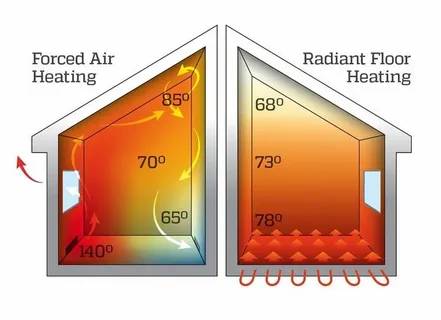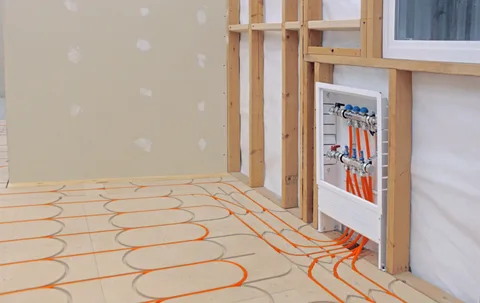In the ever-evolving landscape of modern living, homeowners and designers alike are constantly on the lookout for solutions that combine comfort, efficiency, and sustainability. One such innovative solution that has been gaining popularity is Radiant-Heat. Unlike conventional heating systems, Radiant Heat offers a unique way of warming spaces that enhances comfort while providing energy efficiency. But what exactly is Radiant-Heat, and why should you consider it for your home? This blog post delves into the workings and benefits of Radiant-Heat, offering insights into why it’s a compelling choice for today’s homeowners.
Understanding How Radiant-Heat Works
Radiant-Heat operates by directly heating surfaces and objects in a room rather than the air. This method involves installing heating elements beneath floors, within walls, or in ceilings, from where the heat radiates outward to warm the space evenly. There are two primary types of Radiant-Heat systems: electric and hydronic. Electric systems employ cables or mats that generate heat when an electrical current passes through them.
Hydronic systems, on the other hand, circulate heated water through a network of pipes embedded in the floor. Both systems ensure a consistent and gentle warmth, distinct from the uneven heating often associated with traditional forced-air systems. Radiant-Heat provides an efficient and effective means of creating a comfortable indoor environment.
The Advantages of Radiant-Heat over Traditional Heating
One of the standout advantages of Radiant-Heat is its superior efficiency compared to traditional heating systems. Forced-air systems often suffer from heat loss through ductwork and inconsistent temperature distribution. Radiant-Heat, by contrast, delivers warmth directly to the surfaces and objects within a room, minimising energy waste and ensuring a more even heat distribution. This direct approach results in a more comfortable and stable indoor environment.
Another significant benefit is the quiet operation of Radiant-Heat systems. Unlike the noisy blowers and vents associated with forced-air systems, Radiant-Heat operates silently, contributing to a more peaceful living space. Additionally, because there are no moving parts to circulate air, Radiant-Heat systems do not create drafts, which can be particularly bothersome during colder months.
Radiant-Heat also promotes better indoor air quality. Traditional heating systems can circulate dust, pollen, and other allergens, which may aggravate respiratory issues. In contrast, Radiant-Heat does not move air around, thereby reducing the spread of these particles and creating a healthier environment for allergy sufferers. Finally, the consistent warmth provided by Radiant-Heat is especially advantageous in homes with high ceilings, where traditional systems might struggle to maintain a comfortable temperature. This uniform heat distribution ensures that every corner of the room remains cosy, enhancing overall comfort levels.
Enhancing Home Comfort with Radiant-Heat
Radiant-Heat offers an unparalleled level of comfort by ensuring an even distribution of warmth across surfaces, eliminating cold spots in the room. This system emits heat from the floor, providing a cosy atmosphere that is particularly beneficial during the coldest winter months. Homeowners can enjoy the sensation of warm floors, which is especially comforting in areas like bathrooms and kitchens where tile and stone surfaces can feel particularly chilly.
Additionally, Radiant-Heat systems allow for precise temperature control, enabling the creation of different heating zones within the home. This zoning capability means that each room can be tailored to individual preferences, enhancing personalised comfort. Whether it’s a slightly warmer bathroom in the morning or a cooler bedroom at night, Radiant-Heat makes it possible to customise the indoor climate to suit daily routines.
The gentle and consistent warmth from Radiant-Heat also means fewer fluctuations in temperature, which can often lead to discomfort. This stable indoor environment is ideal for maintaining a comfortable living space, free from the sudden chills that can occur with traditional forced-air systems. By providing steady and reliable warmth, Radiant-Heat ensures that every corner of your home remains inviting and comfortable, no matter the season.
Energy Efficiency and Cost Savings
Radiant-Heat systems offer significant energy efficiency by directly heating surfaces and objects in a room, rather than the air, reducing overall energy consumption. This method ensures that warmth is distributed evenly across the space, eliminating the need for frequent reheating and reducing energy waste. The even distribution of heat means that Radiant-Heat systems can maintain a consistent temperature with less energy, leading to lower utility bills.
Additionally, the efficiency of Radiant-Heat systems means that homeowners can benefit from long-term cost savings. Despite the initial investment being higher than traditional heating systems, the reduction in energy consumption over time can offset the upfront costs. This results in substantial savings on energy bills in the long run.
The ability to zone heating in different areas of the home further enhances energy efficiency. Homeowners can tailor the heating to specific rooms based on usage, ensuring that energy is not wasted on unoccupied spaces. This targeted approach allows for more precise control over energy use, contributing to additional cost savings.
By efficiently using energy to heat spaces directly, Radiant-Heat systems also contribute to a reduced carbon footprint. This environmentally friendly aspect appeals to those looking to adopt more sustainable living practices.
Health Benefits of Radiant Heat Systems
Radiant Heat systems offer a range of health benefits, particularly for individuals with respiratory conditions. Traditional forced-air systems can exacerbate allergies and asthma by circulating dust, pollen, and other airborne particles throughout the home. In contrast, Radiant-Heat works by heating surfaces rather than the air, significantly reducing the movement of these allergens and contributing to a cleaner and healthier indoor environment.
Optimal Humidity
Another advantage of Radiant-Heat is its ability to maintain optimal humidity levels. Forced-air systems often dry out the air, leading to discomfort such as dry skin and irritated respiratory passages. Radiant-Heat avoids this issue, helping to preserve indoor humidity and creating a more comfortable atmosphere, especially during the dry winter months.
Uniform Warmth
The uniform warmth provided by Radiant-Heat also helps to prevent mould growth. Traditional heating systems can create cold spots in corners or behind furniture, areas where moisture can accumulate and foster mould. By ensuring even heat distribution, Radiant-Heat minimises these cold, damp areas, contributing to a healthier living space.
Relief from Pain
Finally, the gentle and consistent warmth from Radiant-Heat can provide relief from aches and pains. The even heat can soothe sore muscles and joints, making it particularly beneficial for those with arthritis or similar conditions. This added level of comfort can enhance overall well-being and improve quality of life.
Installation and Maintenance Considerations
Installing Radiant-Heat systems requires thoughtful planning and professional consultation, particularly for existing homes where retrofitting can be complex. Hydronic systems, known for their efficiency, involve the installation of a network of pipes to circulate heated water, making them more challenging to retrofit but ideal for new builds. On the other hand, electric systems, which use heating cables or mats, are generally easier to install and can be a suitable option for smaller spaces or as supplementary heating.
When it comes to maintenance, Radiant-Heat systems are relatively low-maintenance compared to traditional heating systems. Hydronic systems may require periodic checks to ensure there are no leaks in the piping and that the water heater is functioning efficiently. Electric systems also need occasional inspections to verify that the heating elements are operating correctly. Regular maintenance checks can help in identifying potential issues early, ensuring the system’s longevity and efficiency.
Overall, whether opting for an electric or hydronic system, homeowners should work with experienced installers to ensure proper integration and optimal performance of their Radiant-Heat system.
The Versatility of Radiant-Heat Systems
Radiant-Heat systems are remarkably versatile, accommodating a wide range of flooring types, including tile, hardwood, laminate, and carpet. This flexibility allows homeowners to integrate Radiant-Heat into various rooms without compromising on interior aesthetics or function. For instance, the warmth provided by Radiant-Heat is particularly beneficial in spaces with cold flooring surfaces, such as bathrooms and kitchens, making these areas more comfortable to walk on during colder months.
Beyond floors, Radiant-Heat can also be installed within walls or ceilings, offering additional options for efficient and discreet heating. This adaptability makes it an ideal choice for rooms with unique layouts or design elements, allowing for seamless integration into the existing decor. Whether you are looking to heat a single room, an entire home, or specific zones, Radiant-Heat systems can be customised to meet your needs.
Another notable advantage of Radiant-Heat is its suitability for both new constructions and renovations. While hydronic systems are often favoured for new builds due to their efficiency, electric Radiant-Heat systems offer a simpler installation process, making them an excellent option for retrofitting existing homes. This versatility ensures that homeowners can enjoy the benefits of Radiant-Heat regardless of their project’s scope or scale, enhancing comfort and energy efficiency throughout the living space.
Making the Switch to Radiant-Heat: What to Expect
Making the switch to Radiant-Heat is an exciting step towards enhanced home comfort and energy efficiency. The process begins with a thorough assessment by heating professionals to identify the most suitable system for your specific needs and home layout. This evaluation considers factors such as the size of the space, the type of flooring, and whether you are incorporating the system into a new build or retrofitting an existing property.
Once a plan is in place, installation can proceed. For new constructions, hydronic systems are often preferred due to their efficiency and the ability to integrate seamlessly during the building process. In contrast, electric Radiant-Heat systems may be more suitable for retrofits, as they are generally easier and quicker to install, requiring less invasive procedures.
After installation, it’s crucial to familiarise yourself with the operation of your new Radiant-Heat system. Unlike traditional forced-air heating, Radiant-Heat may take a bit of time to reach the desired temperature, but it maintains warmth more consistently and efficiently. Users often appreciate the silent operation and lack of air drafts, contributing to a more tranquil living environment.
Conclusion
Radiant Heat presents a compelling solution for homeowners seeking enhanced comfort and energy efficiency in their living spaces. Its ability to provide consistent, gentle warmth through direct heating of surfaces makes it superior to traditional forced-air systems, eliminating cold spots and reducing energy waste. The versatility of Radiant-Heat allows it to be integrated seamlessly into various flooring types and home designs, whether in new constructions or retrofits. Additionally, its silent operation and contribution to improved indoor air quality offer added benefits for a tranquil and healthy home environment.
FAQs
1. Is Radiant Heat suitable for all types of homes?
Absolutely, Radiant Heat can be integrated into both new constructions and existing homes. While retrofitting may be more complex, it is entirely feasible with proper planning and professional assistance.
2. Can Radiant-Heat be used with any type of flooring?
Indeed, Radiant-Heat is compatible with a wide range of flooring materials, including tile, hardwood, laminate, and carpet. This makes it a versatile option for various rooms throughout the home.
3. How does Radiant-Heat impact energy bills?
Radiant-Heat systems are designed for high efficiency, which typically results in reduced energy consumption. Although the initial installation cost may be higher than traditional systems, homeowners often experience lower energy bills in the long run, thanks to the system’s efficient operation.
| Cme Blog Spot |
| Garcias Blogs |
| Yyc Blogs |
| Guiade Blogs |
| Blogs-Hunt |
| Impact-Blog |
| Smarty Blogs |
| Ed Blog |
| Mo Blogs |
| Blogs Em |
| Blog St |
| Related Business Listings |
| Contact Directory |
| Local Business Profiles |



